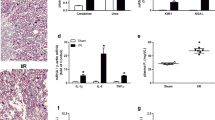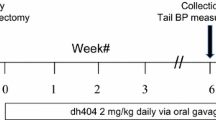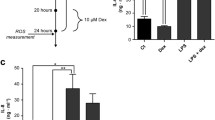Abstract
Magnesium (Mg2+) abnormalities during sepsis have been reported, but the underlying mechanisms during acute inflammation are poorly understood. We hypothesized that a decrease in GFR and/or changes in transporters or channels for Mg2+ could be responsible for the observed Mg2+ abnormalities. Therefore, we studied the metabolism of Mg2+ in a murine model of endotoxemia. LPS-induced hypermagnesemia was paralleled by a decrease in creatinine clearance and an increase in the fractional excretion of Mg2+. In agreement with an altered renal Mg2+ handling, endotoxemia decreased the renal expression of claudin (Cldn) 10b, Cldn16, Cldn19, parvalbumin, and of the solute carrier family (Slc) 41a3. Further, LPS increased the renal expression of Cldn14 and Slc41a1. The renal expression of the transient receptor potential melastin (Trpm) 6, Trpm7, and of cyclin M (Cnnm) 2 was unaltered in response to LPS. In vitro studies support a direct effect on the expression of Cldn10b, Cldn14, Cldn16, and Cldn19. Further, endotoxemia increased the fractional excretion of sodium, which was paralleled by a decrease of important renal sodium transporters. In the large intestine, the expression of Trpm7 was increased in response to LPS, whereas the expression of Trpm6 was decreased. Cnnm4 mRNA levels were unchanged in the large intestine. Further, Cldn12 and Na+-H+ exchanger 3 (Slc9a3) expressions were decreased in the small intestine in response to LPS. Our findings indicate that endotoxemia is associated with hypermagnesemia and a disturbed Mg2+ handling. It seems likely that LPS-induced hypermagnesemia is due to the decrease in renal function in response to LPS.







Similar content being viewed by others
References
Alexander RT, Dimke H (2017) Effect of diuretics on renal tubular transport of calcium and magnesium. Am J Physiol Ren Physiol 312:F998–F1015. https://doi.org/10.1152/ajprenal.00032.2017
Beggs MR, Appel I, Svenningsen P, Skjodt K, Alexander RT, Dimke H (2017) Expression of transcellular and paracellular calcium and magnesium transport proteins in renal and intestinal epithelia during lactation. Am J Physiol Ren Physiol 313:F629–F640. https://doi.org/10.1152/ajprenal.00680.2016
Blaine J, Chonchol M, Levi M (2015) Renal control of calcium, phosphate, and magnesium homeostasis. Clin J Am Soc Nephrol 10:1257–1272. https://doi.org/10.2215/CJN.09750913
Blanchard A, Bockenhauer D, Bolignano D, Calo LA, Cosyns E, Devuyst O, Ellison DH, Karet Frankl FE, Knoers NV, Konrad M, Lin SH, Vargas-Poussou R (2017) Gitelman syndrome: consensus and guidance from a kidney disease: improving global outcomes (KDIGO) controversies conference. Kidney Int 91:24–33. https://doi.org/10.1016/j.kint.2016.09.046
Bourgeois S, Rossignol P, Grelac F, Chalumeau C, Klein C, Laghmani K, Chambrey R, Bruneval P, Duong JP, Poggioli J, Houillier P, Paillard M, Kellermann O, Froissart M (2003) Differentiated thick ascending limb (TAL) cultured cells derived from SV40 transgenic mice express functional apical NHE2 isoform: effect of nitric oxide. Pflugers Arch 446:672–683. https://doi.org/10.1007/s00424-003-1108-x
Boyden LM, Choi M, Choate KA, Nelson-Williams CJ, Farhi A, Toka HR, Tikhonova IR, Bjornson R, Mane SM, Colussi G, Lebel M, Gordon RD, Semmekrot BA, Poujol A, Valimaki MJ, De Ferrari ME, Sanjad SA, Gutkin M, Karet FE, Tucci JR, Stockigt JR, Keppler-Noreuil KM, Porter CC, Anand SK, Whiteford ML, Davis ID, Dewar SB, Bettinelli A, Fadrowski JJ, Belsha CW, Hunley TE, Nelson RD, Trachtman H, Cole TR, Pinsk M, Bockenhauer D, Shenoy M, Vaidyanathan P, Foreman JW, Rasoulpour M, Thameem F, Al-Shahrouri HZ, Radhakrishnan J, Gharavi AG, Goilav B, Lifton RP (2012) Mutations in kelch-like 3 and cullin 3 cause hypertension and electrolyte abnormalities. Nature 482:98–102. https://doi.org/10.1038/nature10814
Breiderhoff T, Himmerkus N, Drewell H, Plain A, Gunzel D, Mutig K, Willnow TE, Muller D, Bleich M (2018) Deletion of claudin-10 rescues claudin-16-deficient mice from hypomagnesemia and hypercalciuria. Kidney Int 93:580–588. https://doi.org/10.1016/j.kint.2017.08.029
Breiderhoff T, Himmerkus N, Stuiver M, Mutig K, Will C, Meij IC, Bachmann S, Bleich M, Willnow TE, Muller D (2012) Deletion of claudin-10 (Cldn10) in the thick ascending limb impairs paracellular sodium permeability and leads to hypermagnesemia and nephrocalcinosis. Proc Natl Acad Sci U S A 109:14241–14246. https://doi.org/10.1073/pnas.1203834109
Broner CW, Stidham GL, Westenkirchner DF, Tolley EA (1990) Hypermagnesemia and hypocalcemia as predictors of high mortality in critically ill pediatric patients. Crit Care Med 18:921–928
Cheungpasitporn W, Thongprayoon C, Erickson SB (2015) Admission hypomagnesemia and hypermagnesemia increase the risk of acute kidney injury. Ren Fail 37:1175–1179. https://doi.org/10.3109/0886022X.2015.1057471
Curry JN, Yu ASL (2018) Magnesium handling in the kidney. Adv Chronic Kidney Dis 25:236–243. https://doi.org/10.1053/j.ackd.2018.01.003
de Baaij JH (2015) The art of magnesium transport. Magnes Res 28:85–91. https://doi.org/10.1684/mrh.2015.0388
Dhar A, Castillo L (2011) Insulin resistance in critical illness. Curr Opin Pediatr 23:269–274. https://doi.org/10.1097/MOP.0b013e3283464b3e
Doi K, Yuen PS, Eisner C, Hu X, Leelahavanichkul A, Schnermann J, Star RA (2009) Reduced production of creatinine limits its use as marker of kidney injury in sepsis. J Am Soc Nephrol 20:1217–1221. https://doi.org/10.1681/ASN.2008060617
Eadon MT, Hack BK, Xu C, Ko B, Toback FG, Cunningham PN (2012) Endotoxemia alters tight junction gene and protein expression in the kidney. Am J Physiol Ren Physiol 303:F821–F830. https://doi.org/10.1152/ajprenal.00023.2012
Efrati E, Hirsch A, Kladnitsky O, Rozenfeld J, Kaplan M, Zinder O, Zelikovic I (2010) Transcriptional regulation of the claudin-16 gene by Mg2+ availability. Cell Physiol Biochem 25:705–714. https://doi.org/10.1159/000315090
Eisner C, Faulhaber-Walter R, Wang Y, Leelahavanichkul A, Yuen PS, Mizel D, Star RA, Briggs JP, Levine M, Schnermann J (2010) Major contribution of tubular secretion to creatinine clearance in mice. Kidney Int 77:519–526. https://doi.org/10.1038/ki.2009.501
El-Achkar TM, Plotkin Z, Marcic B, Dagher PC (2007) Sepsis induces an increase in thick ascending limb Cox-2 that is TLR4 dependent. Am J Physiol Ren Physiol 293:F1187–F1196. https://doi.org/10.1152/ajprenal.00217.2007
Elin RJ (1988) Magnesium metabolism in health and disease. Dis Mon 34:161–218 https://doi.org/
Escuela MP, Guerra M, Anon JM, Martinez-Vizcaino V, Zapatero MD, Garcia-Jalon A, Celaya S (2005) Total and ionized serum magnesium in critically ill patients. Intensive Care Med 31:151–156. https://doi.org/10.1007/s00134-004-2508-x
Ferioli S, Zierler S, Zaisserer J, Schredelseker J, Gudermann T, Chubanov V (2017) TRPM6 and TRPM7 differentially contribute to the relief of heteromeric TRPM6/7 channels from inhibition by cytosolic Mg(2+) and Mg.ATP. Sci Rep 7:8806. https://doi.org/10.1038/s41598-017-08144-1
Ferre S, Hoenderop JG, Bindels RJ (2012) Sensing mechanisms involved in Ca2+ and Mg2+ homeostasis. Kidney Int 82:1157–1166. https://doi.org/10.1038/ki.2012.179
Fleischmann C, Thomas-Rueddel DO, Hartmann M, Hartog CS, Welte T, Heublein S, Dennler U, Reinhart K (2016) Hospital incidence and mortality rates of Sepsis. Dtsch Arztebl Int 113:159–166. https://doi.org/10.3238/arztebl.2016.0159
Fourrier F, Jallot A, Leclerc L, Jourdain M, Racadot A, Chagnon JL, Rime A, Chopin C (1994) Sex steroid hormones in circulatory shock, sepsis syndrome, and septic shock. Circ Shock 43:171–178
Garcia-Hernandez V, Quiros M, Nusrat A (2017) Intestinal epithelial claudins: expression and regulation in homeostasis and inflammation. Ann N Y Acad Sci 1397:66–79. https://doi.org/10.1111/nyas.13360
Gimenez-Mascarell P, Schirrmacher CE, Martinez-Cruz LA, Muller D (2018) Novel aspects of renal magnesium homeostasis. Front Pediatr 6(77). https://doi.org/10.3389/fped.2018.00077
Glaudemans B, Knoers NV, Hoenderop JG, Bindels RJ (2010) New molecular players facilitating Mg(2+) reabsorption in the distal convoluted tubule. Kidney Int 77:17–22. https://doi.org/10.1038/ki.2009.358
Gomez H, Ince C, De Backer D, Pickkers P, Payen D, Hotchkiss J, Kellum JA (2014) A unified theory of sepsis-induced acute kidney injury: inflammation, microcirculatory dysfunction, bioenergetics, and the tubular cell adaptation to injury. Shock 41:3–11. https://doi.org/10.1097/SHK.0000000000000052
Gong Y, Hou J (2017) Claudins in barrier and transport function-the kidney. Pflugers Arch 469:105–113. https://doi.org/10.1007/s00424-016-1906-6
Groenestege WM, Hoenderop JG, van den Heuvel L, Knoers N, Bindels RJ (2006) The epithelial Mg2+ channel transient receptor potential melastatin 6 is regulated by dietary Mg2+ content and estrogens. J Am Soc Nephrol 17:1035–1043. https://doi.org/10.1681/ASN.2005070700
Haider DG, Lindner G, Ahmad SS, Sauter T, Wolzt M, Leichtle AB, Fiedler GM, Exadaktylos AK, Fuhrmann V (2015) Hypermagnesemia is a strong independent risk factor for mortality in critically ill patients: results from a cross-sectional study. Eur J Intern Med 26:504–507. https://doi.org/10.1016/j.ejim.2015.05.013
Hocherl K, Dreher F, Vitzthum H, Kohler J, Kurtz A (2002) Cyclosporine A suppresses cyclooxygenase-2 expression in the rat kidney. J Am Soc Nephrol 13:2427–2436
Hocherl K, Schmidt C, Bucher M (2009) COX-2 inhibition attenuates endotoxin-induced downregulation of organic anion transporters in the rat renal cortex. Kidney Int 75:373–380. https://doi.org/10.1038/ki.2008.557
Hocherl K, Schmidt C, Kurt B, Bucher M (2010) Inhibition of NF-kappaB ameliorates sepsis-induced downregulation of aquaporin-2/V2 receptor expression and acute renal failure in vivo. Am J Physiol Ren Physiol 298:F196–F204. https://doi.org/10.1152/ajprenal.90607.2008
Hollifield JW (1986) Thiazide treatment of hypertension. Effects of thiazide diuretics on serum potassium, magnesium, and ventricular ectopy. Am J Med 80:8–12
Horibata K, Tanoue A, Ito M, Takemura Y (2016) Relationship between renal function and serum magnesium concentration in elderly outpatients treated with magnesium oxide. Geriatr Gerontol Int 16:600–605. https://doi.org/10.1111/ggi.12530
Hou J, Renigunta A, Gomes AS, Hou M, Paul DL, Waldegger S, Goodenough DA (2009) Claudin-16 and claudin-19 interaction is required for their assembly into tight junctions and for renal reabsorption of magnesium. Proc Natl Acad Sci U S A 106:15350–15355. https://doi.org/10.1073/pnas.0907724106
Hou J, Shan Q, Wang T, Gomes AS, Yan Q, Paul DL, Bleich M, Goodenough DA (2007) Transgenic RNAi depletion of claudin-16 and the renal handling of magnesium. J Biol Chem 282:17114–17122. https://doi.org/10.1074/jbc.M700632200
Ikari A, Okude C, Sawada H, Sasaki Y, Yamazaki Y, Sugatani J, Degawa M, Miwa M (2008) Activation of a polyvalent cation-sensing receptor decreases magnesium transport via claudin-16. Biochim Biophys Acta 1778:283–290. https://doi.org/10.1016/j.bbamem.2007.10.002
Lameris AL, Huybers S, Kaukinen K, Makela TH, Bindels RJ, Hoenderop JG, Nevalainen PI (2013) Expression profiling of claudins in the human gastrointestinal tract in health and during inflammatory bowel disease. Scand J Gastroenterol 48:58–69. https://doi.org/10.3109/00365521.2012.741616
Leelahavanichkul A, Souza AC, Street JM, Hsu V, Tsuji T, Doi K, Li L, Hu X, Zhou H, Kumar P, Schnermann J, Star RA, Yuen PS (2014) Comparison of serum creatinine and serum cystatin C as biomarkers to detect sepsis-induced acute kidney injury and to predict mortality in CD-1 mice. Am J Physiol Ren Physiol 307:F939–F948. https://doi.org/10.1152/ajprenal.00025.2013
Li J, Zheng Y, Li MX, Yang CW, Liu YF (2018) Tanshinone IIA alleviates lipopolysaccharide-induced acute lung injury by downregulating TRPM7 and pro-inflammatory factors. J Cell Mol Med 22:646–654. https://doi.org/10.1111/jcmm.13350
Liu A, Wu J, Yang C, Wu Y, Zhang Y, Zhao F, Wang H, Yuan L, Song L, Zhu T, Fan Y, Yang B (2018) TRPM7 in CHBP-induced renoprotection upon ischemia reperfusion-related injury. Sci Rep 8:–5510. https://doi.org/10.1038/s41598-018-22852-2
Mayan H, Vered I, Mouallem M, Tzadok-Witkon M, Pauzner R, Farfel Z (2002) Pseudohypoaldosteronism type II: marked sensitivity to thiazides, hypercalciuria, normomagnesemia, and low bone mineral density. J Clin Endocrinol Metab 87:3248–3254. https://doi.org/10.1210/jcem.87.7.8449
Mederle K, Meurer M, Castrop H, Hocherl K (2015) Inhibition of COX-1 attenuates the formation of thromboxane A2 and ameliorates the acute decrease in glomerular filtration rate in endotoxemic mice. Am J Physiol Ren Physiol 309:F332–F340. https://doi.org/10.1152/ajprenal.00567.2014
Mederle K, Schweda F, Kattler V, Doblinger E, Miyata K, Hocherl K, Oike Y, Castrop H (2013) The angiotensin II AT1 receptor-associated protein Arap1 is involved in sepsis-induced hypotension. Crit Care 17:R130. https://doi.org/10.1186/cc12809
Meurer M, Ebert K, Schweda F, Hocherl K (2018) The renal vasodilatory effect of prostaglandins is ameliorated in isolated-perfused kidneys of endotoxemic mice. Pflugers Arch 470:1691–1703. https://doi.org/10.1007/s00424-018-2183-3
Meurer M, Hocherl K (2019) Endotoxaemia differentially regulates the expression of renal Ca(2+) transport proteins in mice. Acta Physiol (Oxford) 225:e13175. https://doi.org/10.1111/apha.13175
Morrell ED, Kellum JA, Hallows KR, Pastor-Soler NM (2014) Epithelial transport during septic acute kidney injury. Nephrol Dial Transplant 29:1312–1319. https://doi.org/10.1093/ndt/gft503
Olesen ET, de Seigneux S, Wang G, Lutken SC, Frokiaer J, Kwon TH, Nielsen S (2009) Rapid and segmental specific dysregulation of AQP2, S256-pAQP2 and renal sodium transporters in rats with LPS-induced endotoxaemia. Nephrol Dial Transplant 24:2338–2349. https://doi.org/10.1093/ndt/gfp011
Opal SM (2010) Endotoxins and other sepsis triggers. Contrib Nephrol 167:14–24. https://doi.org/10.1159/000315915
Post EH, Kellum JA, Bellomo R, Vincent JL (2017) Renal perfusion in sepsis: from macro- to microcirculation. Kidney Int 91:45–60. https://doi.org/10.1016/j.kint.2016.07.032
Ribeiro AB, Giusti H, Souza APT, Franci CR, Saia RS (2018) Dexamethasone prevents lipopolysaccharide-induced epithelial barrier dysfunction in rat ileum. Shock 49:334–344. https://doi.org/10.1097/SHK.0000000000000930
Schaffers OJM, Hoenderop JGJ, Bindels RJM, de Baaij JHF (2018) The rise and fall of novel renal magnesium transporters. Am J Physiol Ren Physiol 314:F1027–F1033. https://doi.org/10.1152/ajprenal.00634.2017
Schmidt C, Hocherl K, Schweda F, Kurtz A, Bucher M (2007) Regulation of renal sodium transporters during severe inflammation. J Am Soc Nephrol 18:1072–1083. https://doi.org/10.1681/ASN.2006050454
Schreiber A, Theilig F, Schweda F, Hocherl K (2012) Acute endotoxemia in mice induces downregulation of megalin and cubilin in the kidney. Kidney Int 82:53–59. https://doi.org/10.1038/ki.2012.62
Schrezenmeier EV, Barasch J, Budde K, Westhoff T, Schmidt-Ott KM (2017) Biomarkers in acute kidney injury - pathophysiological basis and clinical performance. Acta Physiol (Oxford) 219:554–572. https://doi.org/10.1111/apha.12764
Schrier RW, Wang W (2004) Acute renal failure and sepsis. N Engl J Med 351:159–169. https://doi.org/10.1056/NEJMra032401
Schultheis PJ, Lorenz JN, Meneton P, Nieman ML, Riddle TM, Flagella M, Duffy JJ, Doetschman T, Miller ML, Shull GE (1998) Phenotype resembling Gitelman's syndrome in mice lacking the apical Na+-Cl- cotransporter of the distal convoluted tubule. J Biol Chem 273:29150–29155
Taub PR, Borden KC, Fard A, Maisel A (2012) Role of biomarkers in the diagnosis and prognosis of acute kidney injury in patients with cardiorenal syndrome. Expert Rev Cardiovasc Ther 10:657–667. https://doi.org/10.1586/erc.12.26
Trapani V, Petito V, Di Agostini A, Arduini D, Hamersma W, Pietropaolo G, Luongo F, Arena V, Stigliano E, Lopetuso LR, Gasbarrini A, Wolf FI, Scaldaferri F (2018) Dietary magnesium alleviates experimental murine colitis through upregulation of the transient receptor potential melastatin 6 channel. Inflamm Bowel Dis https://doi.org/10.1093/ibd/izy186, 24, 2198, 2210
Uchino S, Kellum JA, Bellomo R, Doig GS, Morimatsu H, Morgera S, Schetz M, Tan I, Bouman C, Macedo E, Gibney N, Tolwani A, Ronco C, Beginning, Ending Supportive Therapy for the Kidney I (2005) Acute renal failure in critically ill patients: a multinational, multicenter study. JAMA 294:813–818. https://doi.org/10.1001/jama.294.7.813
van Megen WH, Grimm PR, Welling PA, van der Wijst J (2018) Renal sodium and magnesium reabsorption are not coupled in a mouse model of Gordon syndrome. Phys Rep 6:e13728. https://doi.org/10.14814/phy2.13728
Velissaris D, Karamouzos V, Pierrakos C, Aretha D, Karanikolas M (2015) Hypomagnesemia in critically ill sepsis patients. J Clin Med Res 7:911–918. https://doi.org/10.14740/jocmr2351w
Yang CW, Liu H, Li XD, Sui SG, Liu YF (2018) Salvianolic acid B protects against acute lung injury by decreasing TRPM6 and TRPM7 expressions in a rat model of sepsis. J Cell Biochem 119:701–711. https://doi.org/10.1002/jcb.26233
Zhang J, Zhao F, Zhao Y, Wang J, Pei L, Sun N, Shi J (2011) Hypoxia induces an increase in intracellular magnesium via transient receptor potential melastatin 7 (TRPM7) channels in rat hippocampal neurons in vitro. J Biol Chem 286:20194–20207. https://doi.org/10.1074/jbc.M110.148494
Acknowledgements
The technical assistance provided by Ramona Mogge and Andrea Agli is gratefully acknowledged.
Funding
This study was supported by a grant from the Deutsche Forschungsgemeinschaft (DFG, SFB699/B5).
Author information
Authors and Affiliations
Corresponding author
Ethics declarations
All animal experiments were conducted according to the National Institutes of Health Guide for the Care and Use of Laboratory Animals and were approved by the local animal protection committee.
Additional information
Publisher’s note
Springer Nature remains neutral with regard to jurisdictional claims in published maps and institutional affiliations.
This article is part of the Topical Collection on Organ physiology
Rights and permissions
About this article
Cite this article
Meurer, M., Höcherl, K. Deregulated renal magnesium transport during lipopolysaccharide-induced acute kidney injury in mice. Pflugers Arch - Eur J Physiol 471, 619–631 (2019). https://doi.org/10.1007/s00424-019-02261-8
Received:
Revised:
Accepted:
Published:
Issue Date:
DOI: https://doi.org/10.1007/s00424-019-02261-8




